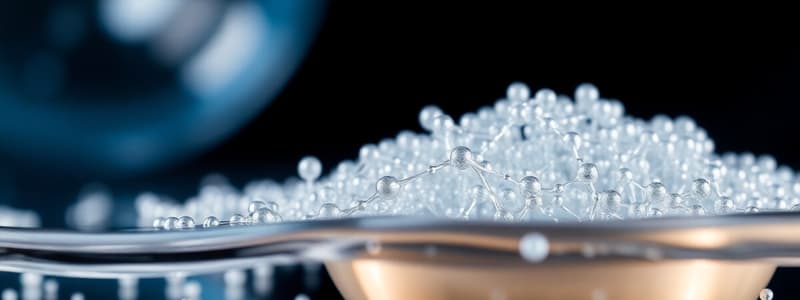Podcast
Questions and Answers
What is the purpose of adjusting the pH to 10.5 during the fabrication of silver nanoparticles?
What is the purpose of adjusting the pH to 10.5 during the fabrication of silver nanoparticles?
- To enhance the color change during the process
- To ensure the stability of the nanoparticles (correct)
- To increase the temperature of the solution
- To initiate the reaction with AgNO3
Which compound was mixed with sodium borohydride to prepare the silver nanoparticles?
Which compound was mixed with sodium borohydride to prepare the silver nanoparticles?
- Sodium chloride
- Calcium carbonate
- Trisodium citrate (correct)
- Potassium permanganate
What method was used to remove unreacted reductants after the silver nanoparticles were prepared?
What method was used to remove unreacted reductants after the silver nanoparticles were prepared?
- Evaporation
- Centrifugation (correct)
- Filtration
- Cooling to room temperature
At what temperature was AgNO3 added drop-wise to the solution during nanoparticle fabrication?
At what temperature was AgNO3 added drop-wise to the solution during nanoparticle fabrication?
What technique is mentioned for analyzing the morphology of silver nanoparticles?
What technique is mentioned for analyzing the morphology of silver nanoparticles?
Flashcards
Silver nanoparticles (AgNPs)
Silver nanoparticles (AgNPs)
Silver nanoparticles (AgNPs) are tiny particles of silver that have unique properties due to their small size. They are used in various applications, including water purification.
Fabrication of Silver Nanoparticles
Fabrication of Silver Nanoparticles
A method used to create silver nanoparticles involves mixing solutions of sodium borohydride (NaBH4), trisodium citrate (TSC), and silver nitrate (AgNO3) at specific temperatures and pH levels. The solution is heated and stirred vigorously to ensure even distribution of components.
Morphology of Silver Nanoparticles
Morphology of Silver Nanoparticles
Transmission Electron Microscopy (TEM) is a technique used to image and analyze the morphology, size, and shape of nanomaterials like silver nanoparticles. TEM images show the structure of the nanoparticles at different magnifying levels.
Zeta Potential of Silver Nanoparticles
Zeta Potential of Silver Nanoparticles
Signup and view all the flashcards
Fourier Transform Infrared Spectroscopy (FTIR)
Fourier Transform Infrared Spectroscopy (FTIR)
Signup and view all the flashcards
Study Notes
Silver Nanoparticle Water Purification
- Synthesis: Aqueous solutions of sodium borohydride (NaBH4) and trisodium citrate (TSC) were mixed and heated to 60°C for 30 minutes in the dark.
- AgNO3 addition: Aqueous silver nitrate (AgNO3) solution was gradually added to the mixture.
- Temperature increase: The temperature was subsequently raised to 90°C.
- pH adjustment: The pH of the solution was adjusted to 10.5 using 0.1 M NaOH while heating continued for 20 minutes.
- Cooling: The nanoparticle suspension was allowed to cool to room temperature.
- Unreacted removal: Unreacted reductants were removed by centrifuging the AgNP suspensions at 12,000 rpm for 15 minutes, followed by three washes.
- Redispersion and storage: The nanoparticles were redispersed in deionized water (DI water) and stored at 4°C.
Nanoparticle Stages
- Stage I: Silver ions (Ag+) undergoing instant nucleation to form Ag0 nuclei, followed by coalescence into clusters.
- Stage II: Citrate reduction at pH 10.5 leads to homogeneous growth of the silver nanoparticles.
- Final product: Citrate-stabilized silver nanoparticles.
Characterization
- UV-Vis Spectroscopy: Extinction spectra were acquired to determine the size of nanoparticles. The study varied sizes from 5 nm to 100 nm.
- Visual Observation (Images): The study included colored solutions corresponding to different nanoparticle sizes. Images confirm the color change related to varying sizes of synthesized nanoparticles.
- Transmission Electron Microscopy (TEM): TEM images were taken to showcase the nanoparticle morphology with magnification levels, showing 100 nm and 200 nm levels.
- Zeta potential: A zeta potential plot of the silver nanoparticles was acquired and plotted.
- FTIR Spectroscopy: Fourier transform infrared spectra (FTIR) illustrated the presence of citrate bonds. The wavenumbers were identified to reveal the specific chemical bonds involved.
Studying That Suits You
Use AI to generate personalized quizzes and flashcards to suit your learning preferences.
Related Documents
Description
This quiz covers the detailed process of synthesizing silver nanoparticles (AgNPs) for water purification. It includes steps such as the mixing of solutions, temperature adjustments, pH modifications, and unreacted removal techniques. Assess your understanding of each stage involved in the nanoparticle production and their implications for water treatment.




